child seat Seat Exeo 2010 Owner's manual
[x] Cancel search | Manufacturer: SEAT, Model Year: 2010, Model line: Exeo, Model: Seat Exeo 2010Pages: 319, PDF Size: 9.64 MB
Page 5 of 319
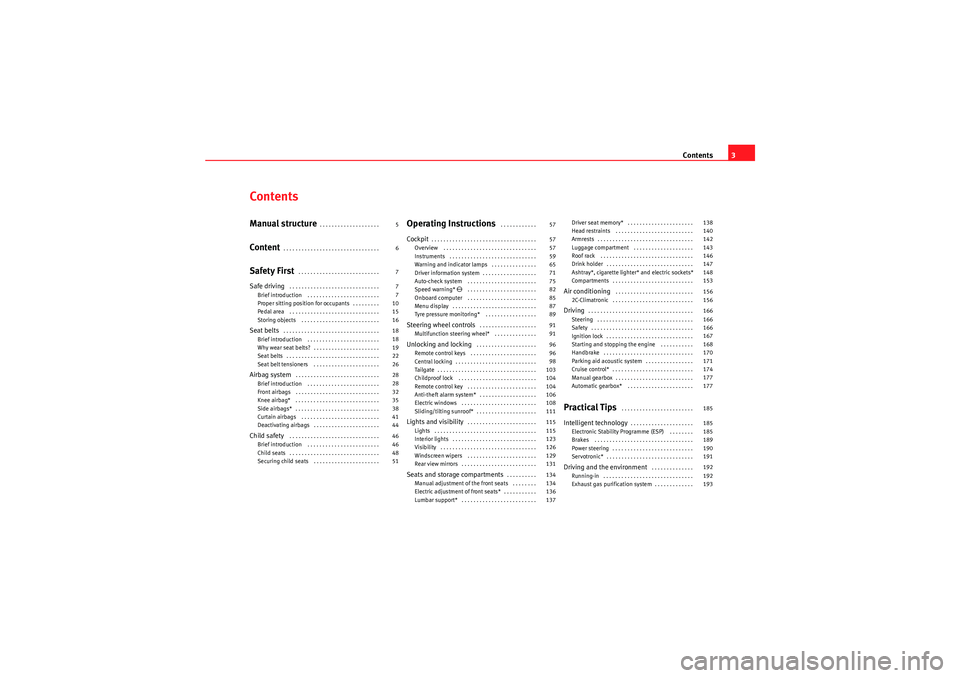
Contents3
ContentsManual structure
. . . . . . . . . . . . . . . . . . . .
Content
. . . . . . . . . . . . . . . . . . . . . . . . . . . . . . . .
Safety First
. . . . . . . . . . . . . . . . . . . . . . . . . . .
Safe driving
. . . . . . . . . . . . . . . . . . . . . . . . . . . . . .
Brief introduction . . . . . . . . . . . . . . . . . . . . . . . .
Proper sitting position for occupants . . . . . . . . .
Pedal area . . . . . . . . . . . . . . . . . . . . . . . . . . . . . .
Storing objects . . . . . . . . . . . . . . . . . . . . . . . . . .
Seat belts
. . . . . . . . . . . . . . . . . . . . . . . . . . . . . . . .
Brief introduction . . . . . . . . . . . . . . . . . . . . . . . .
Why wear seat belts? . . . . . . . . . . . . . . . . . . . . . .
Seat belts . . . . . . . . . . . . . . . . . . . . . . . . . . . . . . .
Seat belt tensioners . . . . . . . . . . . . . . . . . . . . . .
Airbag system
. . . . . . . . . . . . . . . . . . . . . . . . . . . .
Brief introduction . . . . . . . . . . . . . . . . . . . . . . . .
Front airbags . . . . . . . . . . . . . . . . . . . . . . . . . . . .
Knee airbag* . . . . . . . . . . . . . . . . . . . . . . . . . . . .
Side airbags* . . . . . . . . . . . . . . . . . . . . . . . . . . . .
Curtain airbags . . . . . . . . . . . . . . . . . . . . . . . . . .
Deactivating airbags . . . . . . . . . . . . . . . . . . . . . .
Child safety
. . . . . . . . . . . . . . . . . . . . . . . . . . . . . .
Brief introduction . . . . . . . . . . . . . . . . . . . . . . . .
Child seats . . . . . . . . . . . . . . . . . . . . . . . . . . . . . .
Securing child seats . . . . . . . . . . . . . . . . . . . . . .
Operating Instructions
. . . . . . . . . . . .
Cockpit
. . . . . . . . . . . . . . . . . . . . . . . . . . . . . . . . . . .
Overview . . . . . . . . . . . . . . . . . . . . . . . . . . . . . . .
Instruments . . . . . . . . . . . . . . . . . . . . . . . . . . . . .
Warning and indicator lamps . . . . . . . . . . . . . . .
Driver information system . . . . . . . . . . . . . . . . . .
Auto-check system . . . . . . . . . . . . . . . . . . . . . . .
Speed warning* . . . . . . . . . . . . . . . . . . . . . . .
Onboard computer . . . . . . . . . . . . . . . . . . . . . . .
Menu display . . . . . . . . . . . . . . . . . . . . . . . . . . . .
Tyre pressure monitoring* . . . . . . . . . . . . . . . . .
Steering wheel controls
. . . . . . . . . . . . . . . . . . .
Multifunction steering wheel* . . . . . . . . . . . . . .
Unlocking and locking
. . . . . . . . . . . . . . . . . . . .
Remote control keys . . . . . . . . . . . . . . . . . . . . . .
Central locking . . . . . . . . . . . . . . . . . . . . . . . . . . .
Tailgate . . . . . . . . . . . . . . . . . . . . . . . . . . . . . . . . .
Childproof lock . . . . . . . . . . . . . . . . . . . . . . . . . .
Remote control key . . . . . . . . . . . . . . . . . . . . . . .
Anti-theft alarm system* . . . . . . . . . . . . . . . . . . .
Electric windows . . . . . . . . . . . . . . . . . . . . . . . . .
Sliding/tilting sunroof* . . . . . . . . . . . . . . . . . . . .
Lights and visibility
. . . . . . . . . . . . . . . . . . . . . . .
Lights . . . . . . . . . . . . . . . . . . . . . . . . . . . . . . . . . .
Interior lights . . . . . . . . . . . . . . . . . . . . . . . . . . . .
Visibility . . . . . . . . . . . . . . . . . . . . . . . . . . . . . . . .
Windscreen wipers . . . . . . . . . . . . . . . . . . . . . . .
Rear view mirrors . . . . . . . . . . . . . . . . . . . . . . . . .
Seats and storage compartments
. . . . . . . . . .
Manual adjustment of the front seats . . . . . . . .
Electric adjustment of front seats* . . . . . . . . . . .
Lumbar support* . . . . . . . . . . . . . . . . . . . . . . . . . Driver seat memory* . . . . . . . . . . . . . . . . . . . . . .
Head restraints . . . . . . . . . . . . . . . . . . . . . . . . . .
Armrests . . . . . . . . . . . . . . . . . . . . . . . . . . . . . . . .
Luggage compartment . . . . . . . . . . . . . . . . . . . .
Roof rack . . . . . . . . . . . . . . . . . . . . . . . . . . . . . . .
Drink holder . . . . . . . . . . . . . . . . . . . . . . . . . . . . .
Ashtray*, cigarette lighter* and electric sockets*
Compartments . . . . . . . . . . . . . . . . . . . . . . . . . . .
Air conditioning
. . . . . . . . . . . . . . . . . . . . . . . . . .
2C-Climatronic . . . . . . . . . . . . . . . . . . . . . . . . . . .
Driving
. . . . . . . . . . . . . . . . . . . . . . . . . . . . . . . . . . .
Steering . . . . . . . . . . . . . . . . . . . . . . . . . . . . . . . .
Safety . . . . . . . . . . . . . . . . . . . . . . . . . . . . . . . . . .
Ignition lock . . . . . . . . . . . . . . . . . . . . . . . . . . . . .
Starting and stopping the engine . . . . . . . . . . .
Handbrake . . . . . . . . . . . . . . . . . . . . . . . . . . . . . .
Parking aid acoustic system . . . . . . . . . . . . . . . .
Cruise control* . . . . . . . . . . . . . . . . . . . . . . . . . . .
Manual gearbox . . . . . . . . . . . . . . . . . . . . . . . . . .
Automatic gearbox* . . . . . . . . . . . . . . . . . . . . . .
Practical Tips
. . . . . . . . . . . . . . . . . . . . . . . .
Intelligent technology
. . . . . . . . . . . . . . . . . . . . .
Electronic Stability Programme (ESP) . . . . . . . .
Brakes . . . . . . . . . . . . . . . . . . . . . . . . . . . . . . . . .
Power steering . . . . . . . . . . . . . . . . . . . . . . . . . . .
Servotronic* . . . . . . . . . . . . . . . . . . . . . . . . . . . . .
Driving and the environment
. . . . . . . . . . . . . .
Running-in . . . . . . . . . . . . . . . . . . . . . . . . . . . . . .
Exhaust gas purification system . . . . . . . . . . . . .
5
6
7
7
7
10
15
16
18
18
19
22
26
28
28
32
35
38
41
44
46
46
48
51 57
57
57
59
65
71
75
82
85
87
89
91
91
96
96
98
103
104
104
106
108
111
115
115
123
126
129
131
134
134
136
137 138
140
142
143
146
147
148
153
156
156
166
166
166
167
168
170
171
174
177
177
185
185
185
189
190
191
192
192
193
exeo_EN.book Seite 3 Montag, 30. August 2010 4:45 16
Page 9 of 319

Safe driving7
Safety First
Operating Instructions
Practical Tips
Technical Specifications
Safety FirstSafe drivingBrief introductionDear SEAT Driver
Safety first!This chapter contains important in formation, tips, suggestions and
warnings that you should read and consider for both your own safety
and for your passengers’ safety.
WARNING
•This manual contains important information about the operation of the
vehicle, both for the driver and the passengers. The other sections of the
owner’s manual also contain further information that you should be aware
of for your own safety and for the safety of your passengers.•Ensure that the on-board documentation is kept in the vehicle at all
times. This is especially important when lending or selling the vehicle to
another person.
Safety equipment
The safety equipment listed here are part of the vehicle’s
passenger restraint system. They work together to help
reduce the risk of injury in a wide variety of accident situa-
tions.Your safety and the safety of your passengers should not be left to chance. In
the event of an accident, the safety features incorporated in your vehicle are
capable of reducing the risk of injury. These are just a few of the safety
features in your SEAT:•Three-point seat belts optimised for all seats•Belt force limiters for the seats•Belt tension devices for the front seat belts•Front airbags•Side airbags in the front and rear seat backrests*•Head-protection airbags*•Knee airbag for left-hand drive only•ISOFIX anchor points* for ISOFIX child safety seats on the outer rear seats•Height-adjustable head restraints•Adjustable steering column
These individual safety features are harmonised to provide you and your
passengers with the best possible protection in case of an accident. However,
they can only be effective if you and your passengers sit in the correct posi-
tion and adjust and use the safety equipment properly.
exeo_EN.book Seite 7 Montag, 30. August 2010 4:45 16
Page 10 of 319
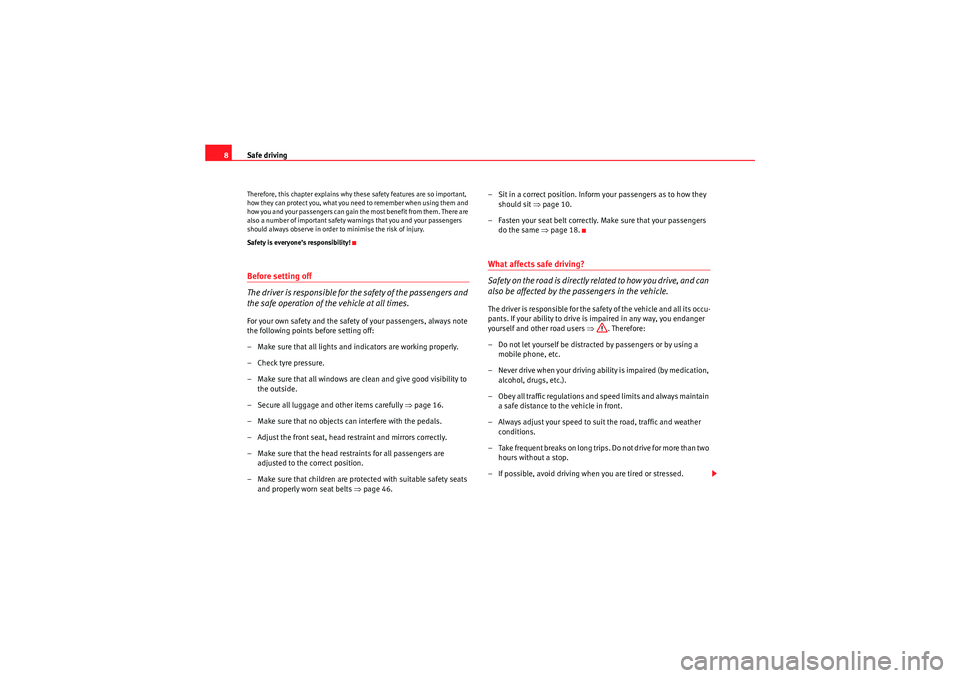
Safe driving
8Therefore, this chapter explains why these safety features are so important,
how they can protect you, what you need to remember when using them and
how you and your passengers can gain the most benefit from them. There are
also a number of important safety warnings that you and your passengers
should always observe in order to minimise the risk of injury.
Safety is everyone’s responsibility!Before setting off
The driver is responsible for the safety of the passengers and
the safe operation of the vehicle at all times.For your own safety and the safety of your passengers, always note
the following points before setting off:
– Make sure that all lights and indicators are working properly.
– Check tyre pressure.
– Make sure that all windows are clean and give good visibility to
the outside.
– Secure all luggage and other items carefully ⇒page 16.
– Make sure that no objects can interfere with the pedals.
– Adjust the front seat, head restraint and mirrors correctly.
– Make sure that the head rest raints for all passengers are
adjusted to the correct position.
– Make sure that children are protected with suitable safety seats and properly worn seat belts ⇒page 46. – Sit in a correct position. Inform
your passengers as to how they
should sit ⇒page 10.
– Fasten your seat belt correctly. Make sure that your passengers
do the same ⇒page 18.
What affects safe driving?
Safety on the road is directly related to how you drive, and can
also be affected by the passengers in the vehicle.The driver is responsible for the safety of the vehicle and all its occu-
pants. If your ability to drive is impaired in any way, you endanger
yourself and other road users ⇒. Therefore:
– Do not let yourself be distracted by passengers or by using a mobile phone, etc.
– Never drive when your driving ability is impaired (by medication, alcohol, drugs, etc.).
– Obey all traffic regulations and speed limits and always maintain a safe distance to the vehicle in front.
– Always adjust your speed to suit the road, traffic and weather conditions.
– Take frequent breaks on long trips. Do not drive for more than two hours without a stop.
– If possible, avoid driving when you are tired or stressed.
exeo_EN.book Seite 8 Montag, 30. August 2010 4:45 16
Page 14 of 319
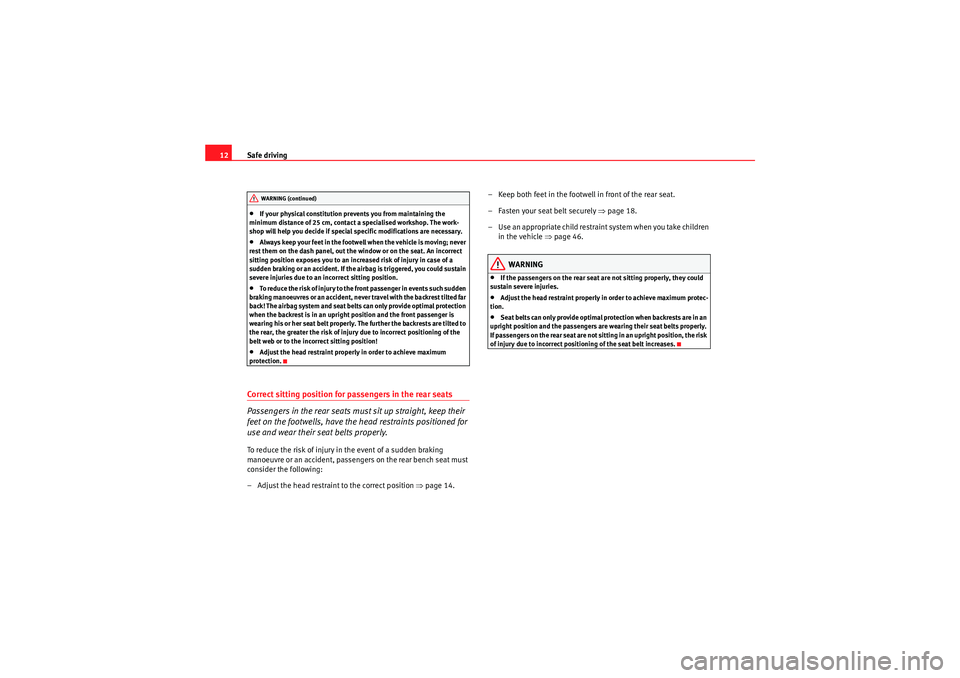
Safe driving
12•If your physical constitution pr events you from maintaining the
minimum distance of 25 cm, contact a specialised workshop. The work-
shop will help you decide if special specific modifications are necessary.•Al ways kee p you r feet in t he footw ell w hen t he vehicle is moving; never
rest them on the dash panel, out the window or on the seat. An incorrect
sitting position exposes you to an increased risk of injury in case of a
sudden braking or an accident. If the airbag is triggered, you could sustain
severe injuries due to an incorrect sitting position.•To reduce the risk of injury to the front passenger in events such sudden
braking manoeuvres or an accident, never travel with the backrest tilted far
back! The airbag system and seat belts can only provide optimal protection
when the backrest is in an upright position and the front passenger is
wearing his or her seat belt properly. The further the backrests are tilted to
the rear, the greater the risk of injury due to incorrect positioning of the
belt web or to the incorrect sitting position!•Adjust the head restraint properly in order to achieve maximum
protection.
Correct sitting position for passengers in the rear seats
Passengers in the rear seats must sit up straight, keep their
feet on the footwells, have the head restraints positioned for
use and wear their seat belts properly.To reduce the risk of injury in the event of a sudden braking
manoeuvre or an accident, passengers on the rear bench seat must
consider the following:
– Adjust the head restraint to the correct position ⇒page 14. – Keep both feet in the footwell in front of the rear seat.
–Fasten your seat belt securely
⇒page 18.
– Use an appropriate child restrain t system when you take children
in the vehicle ⇒page 46.
WARNING
•If the passengers on the rear seat are not sitting properly, they could
sustain severe injuries.•Adjust the head restraint properly in order to achieve maximum protec-
tion.•Seat belts can only provide optimal protection when backrests are in an
upright position and the passengers are wearing their seat belts properly.
If passengers on the rear seat are not sitting in an upright position, the risk
of injury due to incorrect positioning of the seat belt increases.
WARNING (continued)
exeo_EN.book Seite 12 Montag, 30. August 2010 4:45 16
Page 16 of 319
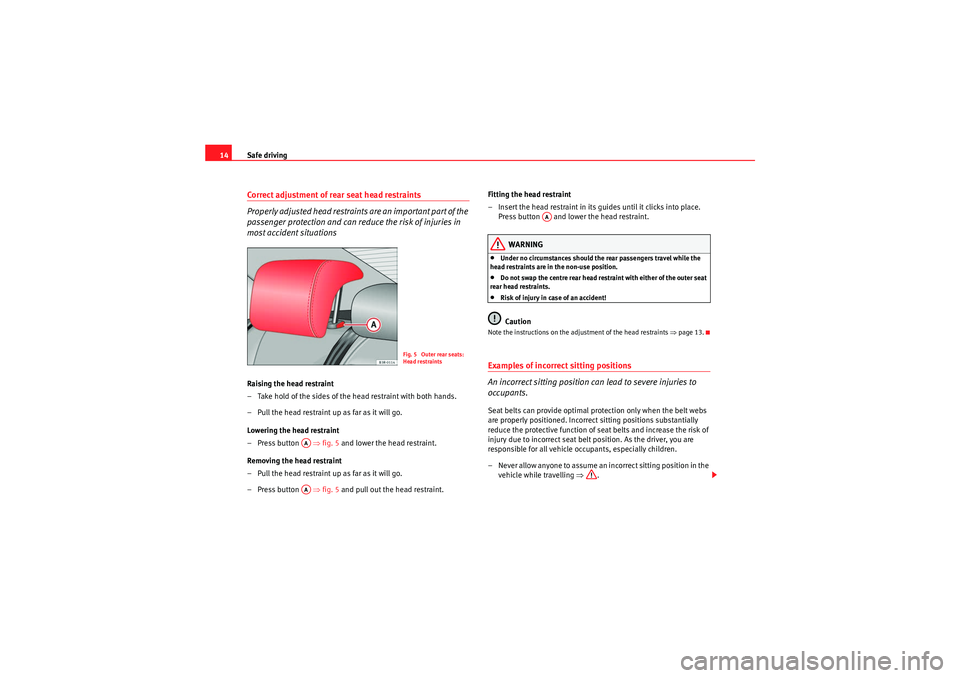
Safe driving
14Correct adjustment of rear seat head restraints
Properly adjusted head restraints are an important part of the
passenger protection and can reduce the risk of injuries in
most accident situationsRaising the head restraint
– Take hold of the sides of the head restraint with both hands.
– Pull the head restraint up as far as it will go.
Lowering the head restraint
–Press button ⇒fig. 5 and lower the head restraint.
Removing the head restraint
– Pull the head restraint up as far as it will go.
–Press button ⇒fig. 5 and pull out the head restraint. Fitting the head restraint
– Insert the head restraint in its guides until it clicks into place.
Press button and lower the head restraint.
WARNING
•Under no circumstances should the rear passengers travel while the
head restraints are in the non-use position.•Do not swap the centre rear head restraint with either of the outer seat
rear head restraints.•Risk of injury in case of an accident!Caution
Note the instructions on the adjustment of the head restraints ⇒page 13.Examples of incorrect sitting positions
An incorrect sitting position can lead to severe injuries to
occupants.Seat belts can provide optimal protection only when the belt webs
are properly positioned. Incorrect sitting positions substantially
reduce the protective function of se at belts and increase the risk of
injury due to incorrect seat belt position. As the driver, you are
responsible for all vehicle occupants, especially children.
– Never allow anyone to assume an incorrect sitting position in the vehicle while travelling ⇒.
Fig. 5 Outer rear seats:
Head restraints
AAAA
AA
exeo_EN.book Seite 14 Montag, 30. August 2010 4:45 16
Page 20 of 319
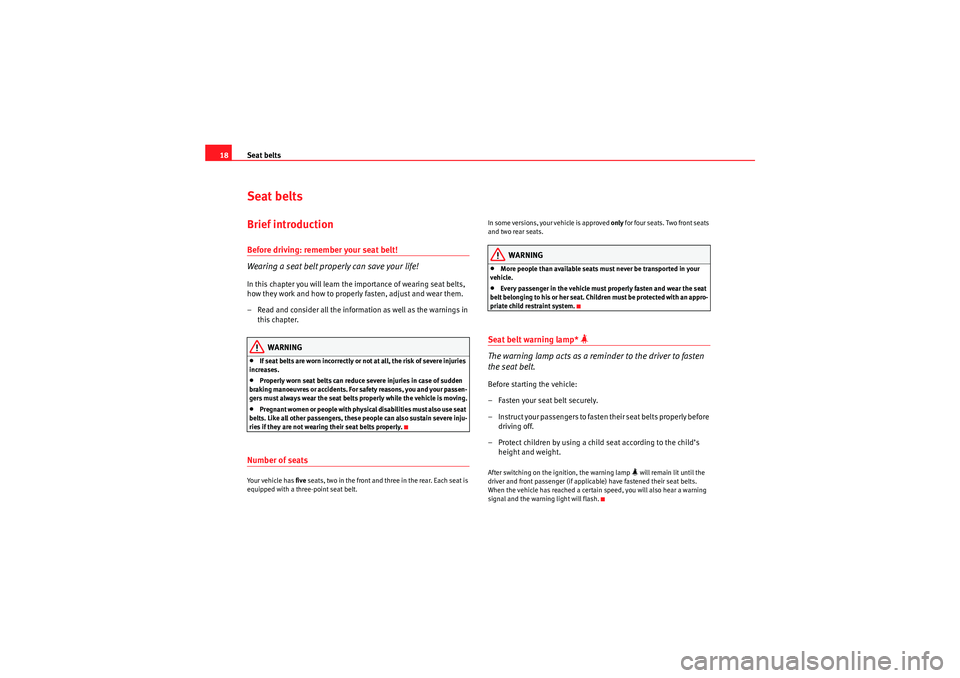
Seat belts
18Seat beltsBrief introductionBefore driving: remember your seat belt!
Wearing a seat belt properly can save your life!In this chapter you will learn the importance of wearing seat belts,
how they work and how to properly fasten, adjust and wear them.
– Read and consider all the informat ion as well as the warnings in
this chapter.
WARNING
•If seat belts are worn incorrectly or not at all, the risk of severe injuries
increases.•Properly worn seat belts can reduce severe injuries in case of sudden
braking manoeuvres or accidents. For safety reasons, you and your passen-
gers must always wear the seat belts properly while the vehicle is moving.•P r e g n a n t w o m e n o r p e o p l e w i t h p h y s i ca l d i s a b i l i t i e s m u s t a l s o u s e s e a t
belts. Like all other passengers, these people can also sustain severe inju-
ries if they are not wearing their seat belts properly.
Number of seatsYour vehicle has five seats, two in the front and three in the rear. Each seat is
equipped with a three-point seat belt. In some versions, your vehicle is approved
only for four seats. Two front seats
and two rear seats.
WARNING
•More people than available seats must never be transported in your
vehicle.•Every passenger in the vehicle must properly fasten and wear the seat
belt belonging to h is or her s eat . Child re n must be protecte d with an appro-
priate child restraint system.
Seat belt warning lamp*
The warning lamp acts as a reminder to the driver to fasten
the seat belt.Before starting the vehicle:
–Fasten your seat belt securely.
– Instruct your passengers to fasten their seat belts properly before driving off.
– Protect children by using a child seat according to the child’s height and weight.After switching on the ignition, the warning lamp
will remain lit until the
driver and front passenger (if applicable) have fastened their seat belts.
When the vehicle has reached a certain speed, you will also hear a warning
signal and the warning light will flash.
exeo_EN.book Seite 18 Montag, 30. August 2010 4:45 16
Page 24 of 319

Seat belts
22•Fasten your seat belt before every trip - even when driving in town. The
o t h e r pass e n ge rs m u s t al s o w ea r t h e s ea t b e l ts a t all t i m e s , o t h e r w is e t h e y
run the risk of being injured.•The seat belt cannot offer its full protection if the seat belt is not posi-
tioned correctly.•Never allow two passengers (even children) to share the same seat belt.•Ke e p b o t h fe e t i n t h e fo o t w e ll i n f ro n t o f yo u r s ea t as l o n g as t h e ve h ic l e
is in motion.•Never unbuckle a seat belt while the vehicle is in motion. Risk of fatal
injury.•The seat belt must never be twisted while it is being worn.•The seat belt should never lie on hard or fragile objects (such as glasses
or pens, etc.) because this can cause injuries.•Do not allow the seat belt to be damaged or jammed, or to rub on any
sharp edges.•Never wear the seat belt under the arm or in any other incorrect posi-
tion.•Loose, bulky clothing (such as an overcoat over a jacket) impairs the
proper fit and function of the belts, reducing their capacity to protect.•The slot in the seat belt buckle must not be blocked with paper or other
objects, as this can prevent the latch plate from engaging securely.•Never use seat belt clips, retaining rings or similar instruments to alter
the position of the belt webbing.•Frayed or torn seat belts or damage to the connections, belt retractors
or parts of the buckle could cause severe injuries in the event of an acci-
dent. Therefore, you must check the condition of all seat belts at regular
intervals.•Seat belts which have been worn in an accident and stretched must be
replaced by a qualified workshop. Renewal may be necessary even if there
is no apparent damage. The belt anchorage should also be checked.
•Do not attempt to repair a damaged seat belt yourself. The seat belts
must not be removed or modified in any way.•The belts must be kept clean, otherwise the retractors may not work
properly ⇒page 216.
Seat beltsSeat belt adjustment
The seat belts for the front and rear occupants are locked into
position by a latch.The seat belt cannot offer its full protection if the seat belt is not
positioned correctly.
WARNING (continued)
WARNING (continued)
Fig. 11 Belt buckle and
latch plate of seat belt
exeo_EN.book Seite 22 Montag, 30. August 2010 4:45 16
Page 26 of 319
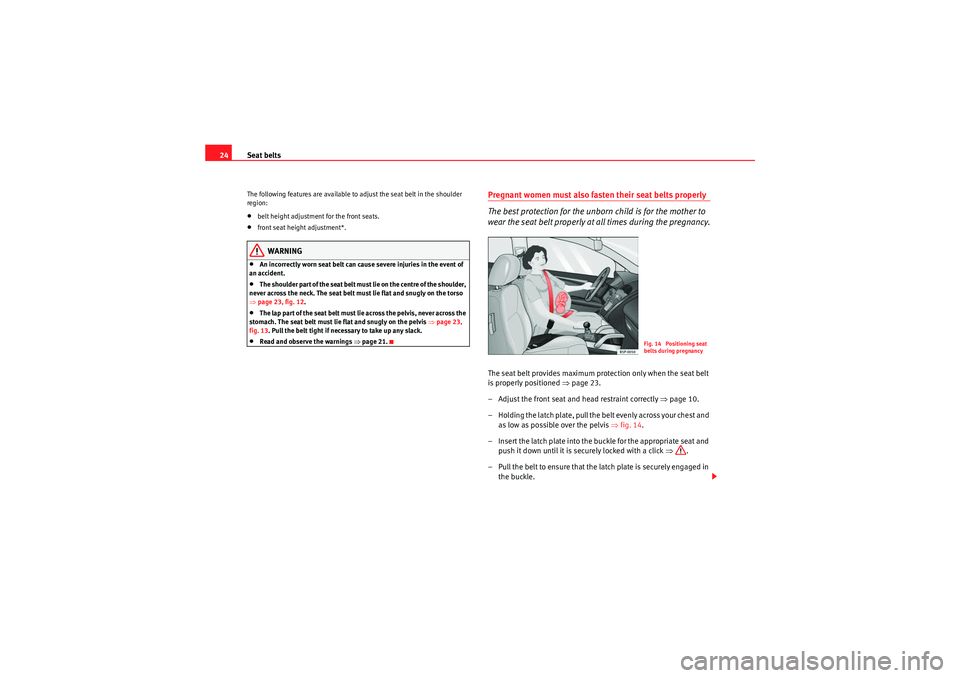
Seat belts
24The following features are available to adjust the seat belt in the shoulder
region:•belt height adjustment for the front seats.•front seat height adjustment*.WARNING
•An incorrectly worn seat belt can cause severe injuries in the event of
an accident.•The shoulder part of the seat belt must lie on the centre of the shoulder,
never across the neck. The seat belt must lie flat and snugly on the torso
⇒ page 23, fig. 12 .•The lap par t of the seat belt must lie across the pelvis, never across the
stomach. The seat belt must lie flat and snugly on the pelvis ⇒page 23,
fig. 13. Pull the belt tight if necessary to take up any slack.•Read and observe the warnings ⇒page 21.
Pregnant women must also fasten their seat belts properly
The best protection for the unborn child is for the mother to
wear the seat belt properly at all times during the pregnancy.The seat belt provides maximum protection only when the seat belt
is properly positioned ⇒page 23.
– Adjust the front seat and head restraint correctly ⇒page 10.
– Holding the latch plate, pull the belt evenly across your chest and as low as possible over the pelvis ⇒fig. 14 .
– Insert the latch plate into the buckle for the appropriate seat and push it down until it is securely locked with a click ⇒.
– Pull the belt to ensure that the latch plate is securely engaged in the buckle.
Fig. 14 Positioning seat
belts during pregnancy
exeo_EN.book Seite 24 Montag, 30. August 2010 4:45 16
Page 28 of 319
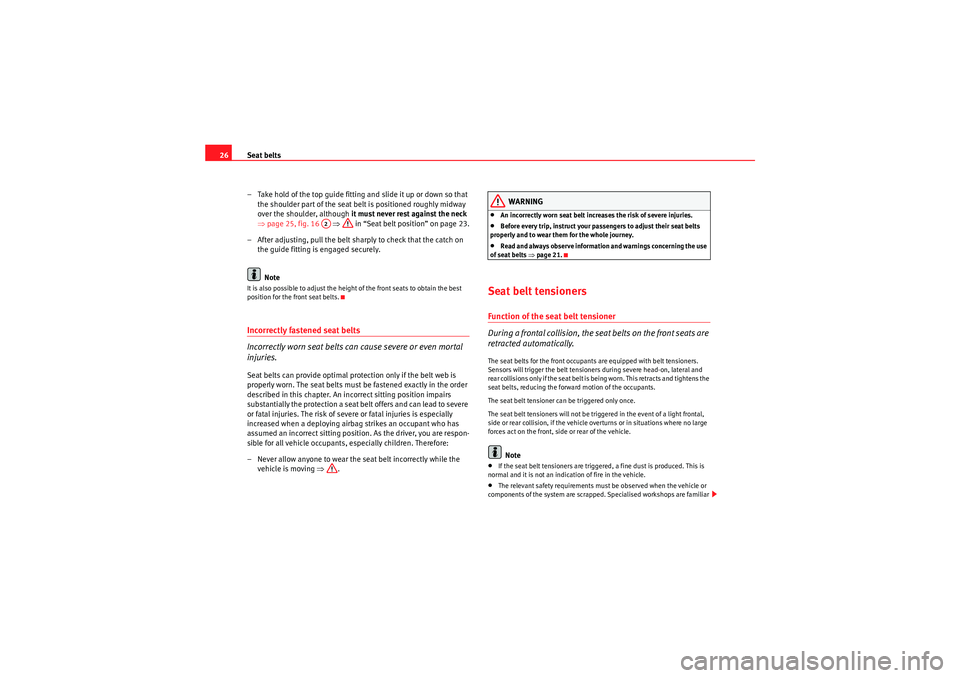
Seat belts
26
– Take hold of the top guide fitting and slide it up or down so that the shoulder part of the seat belt is positioned roughly midway
over the shoulder, although it must never rest against the neck
⇒ page 25, fig. 16 ⇒ in “Seat belt position” on page 23.
– After adjusting, pull the belt sharply to check that the catch on the guide fitting is engaged securely.
NoteIt is also possible to adjust the height of the front seats to obtain the best
position for the front seat belts.Incorrectly fastened seat belts
Incorrectly worn seat belts can cause severe or even mortal
injuries.Seat belts can provide optimal protection only if the belt web is
properly worn. The seat belts must be fastened exactly in the order
described in this chapter. An in correct sitting position impairs
substantially the protection a seat belt offers and can lead to severe
or fatal injuries. The risk of severe or fatal injuries is especially
increased when a deploying airbag strikes an occupant who has
assumed an incorrect sitting position. As the driver, you are respon-
sible for all vehicle occupants, especially children. Therefore:
– Never allow anyone to wear the seat belt incorrectly while the vehicle is moving ⇒.
WARNING
•An incorrectly worn seat belt increases the risk of severe injuries.•Before every trip, instruct your passengers to adjust their seat belts
properly and to wear them for the whole journey.•Read and always observe information and warnings concerning the use
of seat belts ⇒page 21.
Seat belt tensionersFunction of the seat belt tensioner
During a frontal collision, the seat belts on the front seats are
retracted automatically.The seat belts for the front occupants are equipped with belt tensioners.
Sensors will trigger the belt tensioners during severe head-on, lateral and
rear collisions only if the seat belt is being worn. This retracts and tightens the
seat belts, reducing the forward motion of the occupants.
The seat belt tensioner can be triggered only once.
The seat belt tensioners will not be triggered in the event of a light frontal,
side or rear collision, if the vehicle overturns or in situations where no large
forces act on the front, side or rear of the vehicle.
Note
•If the seat belt tensioners are triggered, a fine dust is produced. This is
normal and it is not an indication of fire in the vehicle.•The relevant safety requirements must be observed when the vehicle or
components of the system are scrapped. Specialised workshops are familiar
A2
exeo_EN.book Seite 26 Montag, 30. August 2010 4:45 16
Page 30 of 319
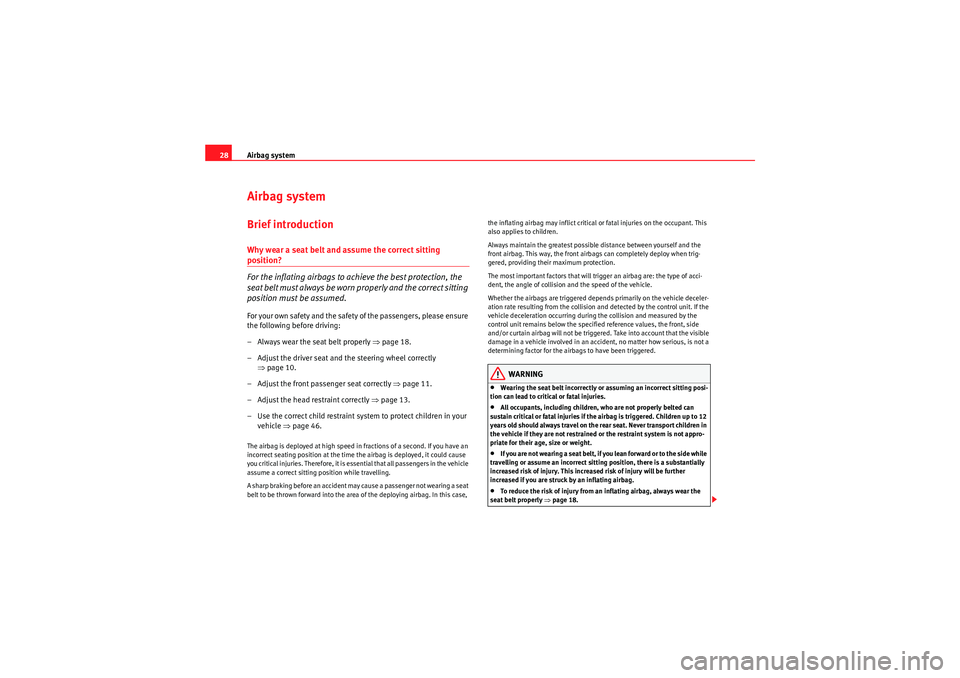
Airbag system
28Airbag systemBrief introductionWhy wear a seat belt and assume the correct sitting position?
For the inflating airbags to achieve the best protection, the
seat belt must always be worn properly and the correct sitting
position must be assumed.For your own safety and the safety of the passengers, please ensure
the following before driving:
– Always wear the seat belt properly ⇒page 18.
– Adjust the driver seat and the steering wheel correctly ⇒page 10.
– Adjust the front passenger seat correctly ⇒page 11.
– Adjust the head restraint correctly ⇒page 13.
– Use the correct child restraint system to protect children in your vehicle ⇒page 46.The airbag is deployed at high speed in fractions of a second. If you have an
incorrect seating position at the time the airbag is deployed, it could cause
you critical injuries. Therefore, it is essential that all passengers in the vehicle
assume a correct sitting position while travelling.
A sharp braking before an accident may cause a passenger not wearing a seat
belt to be thrown forward into the area of the deploying airbag. In this case, the inflating airbag may inflict critical or fatal injuries on the occupant. This
also applies to children.
Always maintain the greatest possible distance between yourself and the
front airbag. This way, the front airbags can completely deploy when trig-
gered, providing their maximum protection.
The most important factors that will trigger an airbag are: the type of acci-
dent, the angle of collision and the speed of the vehicle.
Whether the airbags are triggered depends primarily on the vehicle deceler-
ation rate resulting from the collision and detected by the control unit. If the
vehicle deceleration occurring during the collision and measured by the
control unit remains below the specified reference values, the front, side
and/or curtain airbag will not be triggered. Take into account that the visible
damage in a vehicle involved in an accident, no matter how serious, is not a
determining factor for the airbags to have been triggered.
WARNING
•Wearing the seat belt incorrectly or assuming an incorrect sitting posi-
tion can lead to critical or fatal injuries.•All occupants, including children, who are not properly belted can
sustain critical or fatal injuries if the airbag is triggered. Children up to 12
years old should always travel on the rear seat. Never transport children in
the vehicle if they are not restrained or the restraint system is not appro-
priate for their age, size or weight.•I f yo u are n o t w ea r i ng a s ea t b e l t , i f yo u l e an fo r w a rd o r t o t h e s id e w h il e
travelling or assume an incorrect sitting position, there is a substantially
increased risk of injury. This increased risk of injury will be further
increased if you are struck by an inflating airbag.•To reduce the risk of injury from an inflating airbag, always wear the
seat belt properly ⇒page 18.
exeo_EN.book Seite 28 Montag, 30. August 2010 4:45 16